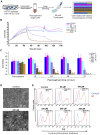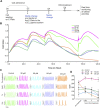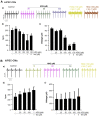In vitro effect of hydroxychloroquine on pluripotent stem cells and their cardiomyocytes derivatives
- PMID: 37502208
- PMCID: PMC10369049
- DOI: 10.3389/fphar.2023.1128382
In vitro effect of hydroxychloroquine on pluripotent stem cells and their cardiomyocytes derivatives
Abstract
Introduction: Hydroxychloroquine (HDQ) is an antimalarial drug that has also shown its effectiveness in autoimmune diseases. Despite having side effects such as retinopathy, neuromyopathy and controversial cardiac toxicity, HDQ has been presented and now intensively studied for the treatment and prevention of coronavirus disease 2019 (COVID-19). Recent works revealed both beneficial and toxic effects during HDQ treatment. The cardiotoxic profile of HDQ remains unclear and identifying risk factors is challenging. Methods: Here, we used well-established cell-cultured to study the cytotoxic effect of HDQ, mouse induced pluripotent stem cells (miPSC) and their cardiomyocytes (CMs) derivatives were exposed to different concentrations of HDQ. Cell colony morphology was assessed by microscopy whereas cell viability was measured by flow cytometry and impedance-based methods. The effect of HDQ on beating activity of mouse and human induced pluripotent stem cell-derived CMs (miPSC-CMs and hiPSC-CMs, respectively) and mouse embryonic stem cell-derived CMs (mESC-CMs) were captured by the xCELLigence RTCA and microelectrode array (MEA) systems. Results and discussion: Our results revealed that 20 µM of HDQ promotes proliferation of stem cells used suggesting that if appropriately monitored, HDQ may have a cardioprotective effect and may also represent a possible candidate for tissue repair. In addition, the field potential signals revealed that higher doses of this medication caused bradycardia that could be reversed with a higher concentration of ß-adrenergic agonist, Isoproterenol (Iso). On the contrary, HDQ caused an increase in the beating rate of hiPSC-CMs, which was further helped upon application of Isoproterenol (Iso) suggesting that HDQ and Iso may also work synergistically. These results indicate that HDQ is potentially toxic at high concentrations and can modulate the beating activity of cardiomyocytes. Moreover, HDQ could have a synergistic inotropic effect with isoproterenol on cardiac cells.
Keywords: cardiotoxicity; differentiation; hydroxychloroquine; proliferation; stem cells.
Copyright © 2023 Kamga Kapchoup, Hescheler and Nguemo.
Conflict of interest statement
The authors declare that the research was conducted in the absence of any commercial or financial relationships that could be construed as a potential conflict of interest.
Figures





Similar articles
-
Evaluation of chronic drug-induced electrophysiological and cytotoxic effects using human-induced pluripotent stem cell-derived cardiomyocytes (hiPSC-CMs).Front Pharmacol. 2023 Jul 10;14:1229960. doi: 10.3389/fphar.2023.1229960. eCollection 2023. Front Pharmacol. 2023. PMID: 37492082 Free PMC article.
-
In vitro chronotropic effects of Erythrina senegalensis DC (Fabaceae) aqueous extract on mouse heart slice and pluripotent stem cell-derived cardiomyocytes.J Ethnopharmacol. 2015 May 13;165:163-72. doi: 10.1016/j.jep.2015.02.002. Epub 2015 Feb 11. J Ethnopharmacol. 2015. PMID: 25680843
-
Evaluation of in vitro models of stem cell-derived cardiomyocytes to screen for potential cardiotoxicity of chemicals.Toxicol In Vitro. 2020 Sep;67:104891. doi: 10.1016/j.tiv.2020.104891. Epub 2020 May 22. Toxicol In Vitro. 2020. PMID: 32446838
-
Moving beyond the comprehensive in vitro proarrhythmia assay: Use of human-induced pluripotent stem cell-derived cardiomyocytes to assess contractile effects associated with drug-induced structural cardiotoxicity.J Appl Toxicol. 2018 Sep;38(9):1166-1176. doi: 10.1002/jat.3611. Epub 2018 Feb 27. J Appl Toxicol. 2018. PMID: 29484688 Review.
-
MicroRNA-mediated maturation of human pluripotent stem cell-derived cardiomyocytes: Towards a better model for cardiotoxicity?Food Chem Toxicol. 2016 Dec;98(Pt A):17-24. doi: 10.1016/j.fct.2016.05.025. Epub 2016 Jun 3. Food Chem Toxicol. 2016. PMID: 27265266 Review.
References
-
- Bourke L., Mccormick J., Franklin J., Stephanou A., Ioannou Y. (2014). O45. Hydroxychloroquine is cardioprotective in neonatal RAT cardiomyocytes exposed to simulated myocardial ischaemic/reperfusion injury: An effect mediated through ERK phosphorylation. Rheumatology 53, i48–i49. 10.1093/rheumatology/keu093.003 - DOI
-
- Browning D. J. (2014). Pharmacology of chloroquine and hydroxychloroquine. Hydroxychloroquine Chloroquine Retin., 35–63. 10.1007/978-1-4939-0597-3_2 - DOI
LinkOut - more resources
Full Text Sources

